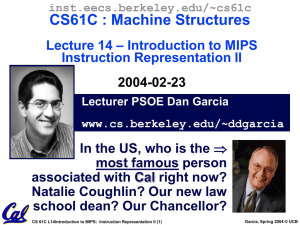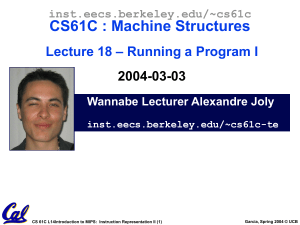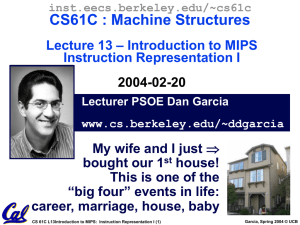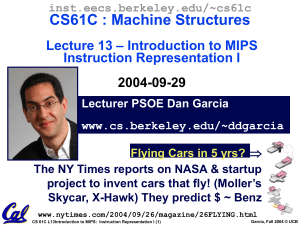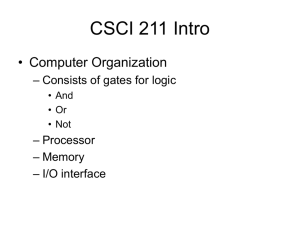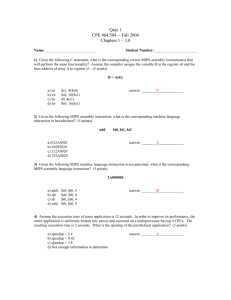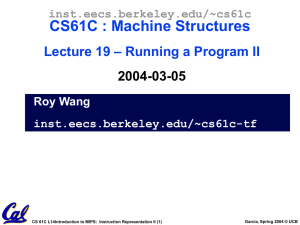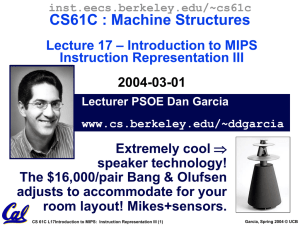CS61C : Machine Structures – Introduction to MIPS Lecture 14 Instruction Representation II
advertisement
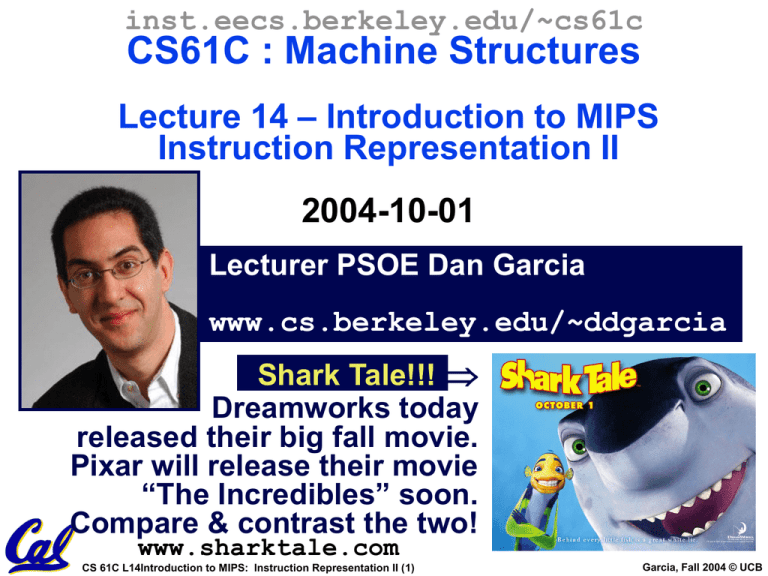
inst.eecs.berkeley.edu/~cs61c
CS61C : Machine Structures
Lecture 14 – Introduction to MIPS
Instruction Representation II
2004-10-01
Lecturer PSOE Dan Garcia
www.cs.berkeley.edu/~ddgarcia
Shark Tale!!!
Dreamworks today
released their big fall movie.
Pixar will release their movie
“The Incredibles” soon.
Compare & contrast the two!
www.sharktale.com
CS 61C L14Introduction to MIPS: Instruction Representation II (1)
Garcia, Fall 2004 © UCB
I-Format Problems (0/3)
• Problem 0: Unsigned # sign-extended?
•addiu, sltiu, sign-extends immediates
to 32 bits. Thus, # is a “signed” integer.
• Rationale
•addiu so that can add w/out overflow
- See K&R pp. 230, 305
•sltiu suffers so that we can have ez HW
- Does this mean we’ll get wrong answers?
- Nope, it means assembler has to handle any
unsigned immediate 215 ≤ n < 216 (I.e., with a
1 in the 15th bit and 0s in the upper 2 bytes)
as it does for numbers that are too large.
CS 61C L14Introduction to MIPS: Instruction Representation II (2)
Garcia, Fall 2004 © UCB
I-Format Problems (1/3)
• Problem 1:
• Chances are that addi, lw, sw and slti
will use immediates small enough to fit in
the immediate field.
• …but what if it’s too big?
• We need a way to deal with a 32-bit
immediate in any I-format instruction.
CS 61C L14Introduction to MIPS: Instruction Representation II (3)
Garcia, Fall 2004 © UCB
I-Format Problems (2/3)
• Solution to Problem 1:
• Handle it in software + new instruction
• Don’t change the current instructions:
instead, add a new instruction to help out
• New instruction:
lui
register, immediate
• stands for Load Upper Immediate
• takes 16-bit immediate and puts these bits
in the upper half (high order half) of the
specified register
• sets lower half to 0s
CS 61C L14Introduction to MIPS: Instruction Representation II (4)
Garcia, Fall 2004 © UCB
I-Format Problems (3/3)
• Solution to Problem 1 (continued):
• So how does lui help us?
• Example:
addi
becomes:
lui
ori
add
$t0,$t0, 0xABABCDCD
$at, 0xABAB
$at, $at, 0xCDCD
$t0,$t0,$at
• Now each I-format instruction has only a 16bit immediate.
• Wouldn’t it be nice if the assembler would
this for us automatically? (later)
CS 61C L14Introduction to MIPS: Instruction Representation II (5)
Garcia, Fall 2004 © UCB
Branches: PC-Relative Addressing (1/5)
• Use I-Format
opcode
rs
rt
immediate
• opcode specifies beq v. bne
• rs and rt specify registers to compare
• What can immediate specify?
•Immediate is only 16 bits
• PC (Program Counter) has byte address of
current instruction being executed;
32-bit pointer to memory
• So immediate cannot specify entire
address to branch to.
CS 61C L14Introduction to MIPS: Instruction Representation II (6)
Garcia, Fall 2004 © UCB
Branches: PC-Relative Addressing (2/5)
• How do we usually use branches?
• Answer: if-else, while, for
• Loops are generally small: typically up to
50 instructions
• Function calls and unconditional jumps are
done using jump instructions (j and jal),
not the branches.
• Conclusion: may want to branch to
anywhere in memory, but a branch often
changes PC by a small amount
CS 61C L14Introduction to MIPS: Instruction Representation II (7)
Garcia, Fall 2004 © UCB
Branches: PC-Relative Addressing (3/5)
• Solution to branches in a 32-bit
instruction: PC-Relative Addressing
• Let the 16-bit immediate field be a
signed two’s complement integer to be
added to the PC if we take the branch.
• Now we can branch ± 215 bytes from
the PC, which should be enough to
cover almost any loop.
• Any ideas to further optimize this?
CS 61C L14Introduction to MIPS: Instruction Representation II (8)
Garcia, Fall 2004 © UCB
Branches: PC-Relative Addressing (4/5)
• Note: Instructions are words, so
they’re word aligned (byte address is
always a multiple of 4, which means it
ends with 00 in binary).
• So the number of bytes to add to the PC
will always be a multiple of 4.
• So specify the immediate in words.
• Now, we can branch ± 215 words from
the PC (or ± 217 bytes), so we can
handle loops 4 times as large.
CS 61C L14Introduction to MIPS: Instruction Representation II (9)
Garcia, Fall 2004 © UCB
Branches: PC-Relative Addressing (5/5)
• Branch Calculation:
• If we don’t take the branch:
PC = PC + 4
PC+4 = byte address of next instruction
• If we do take the branch:
PC = (PC + 4) + (immediate * 4)
• Observations
- Immediate field specifies the number of
words to jump, which is simply the number of
instructions to jump.
- Immediate field can be positive or negative.
- Due to hardware, add immediate to (PC+4),
not to PC; will be clearer why later in course
CS 61C L14Introduction to MIPS: Instruction Representation II (10)
Garcia, Fall 2004 © UCB
Branch Example (1/3)
• MIPS Code:
Loop:
beq
add
addi
j
$9,$0,End
$8,$8,$10
$9,$9,-1
Loop
End:
• beq branch is I-Format:
opcode = 4 (look up in table)
rs = 9 (first operand)
rt = 0 (second operand)
immediate = ???
CS 61C L14Introduction to MIPS: Instruction Representation II (11)
Garcia, Fall 2004 © UCB
Branch Example (2/3)
• MIPS Code:
Loop: beq
addi
addi
j
End:
$9,$0,End
$8,$8,$10
$9,$9,-1
Loop
• Immediate Field:
• Number of instructions to add to (or
subtract from) the PC, starting at the
instruction following the branch.
• In beq case, immediate = 3
CS 61C L14Introduction to MIPS: Instruction Representation II (12)
Garcia, Fall 2004 © UCB
Branch Example (3/3)
• MIPS Code:
Loop: beq
addi
addi
j
End:
$9,$0,End
$8,$8,$10
$9,$9,-1
Loop
decimal representation:
4
9
0
binary representation:
3
000100 01001 00000 0000000000000011
CS 61C L14Introduction to MIPS: Instruction Representation II (13)
Garcia, Fall 2004 © UCB
Questions on PC-addressing
• Does the value in branch field change
if we move the code?
• What do we do if destination is > 215
instructions away from branch?
• Since it’s limited to ± 215 instructions,
doesn’t this generate lots of extra
MIPS instructions?
• Why do we need all these addressing
modes? Why not just one?
CS 61C L14Introduction to MIPS: Instruction Representation II (14)
Garcia, Fall 2004 © UCB
J-Format Instructions (1/5)
• For branches, we assumed that we
won’t want to branch too far, so we
can specify change in PC.
• For general jumps (j and jal), we may
jump to anywhere in memory.
• Ideally, we could specify a 32-bit
memory address to jump to.
• Unfortunately, we can’t fit both a 6-bit
opcode and a 32-bit address into a
single 32-bit word, so we compromise.
CS 61C L14Introduction to MIPS: Instruction Representation II (19)
Garcia, Fall 2004 © UCB
J-Format Instructions (2/5)
• Define “fields” of the following
number of bits each:
6 bits
26 bits
• As usual, each field has a name:
opcode
target address
• Key Concepts
• Keep opcode field identical to R-format
and I-format for consistency.
• Combine all other fields to make room
for large target address.
CS 61C L14Introduction to MIPS: Instruction Representation II (20)
Garcia, Fall 2004 © UCB
J-Format Instructions (3/5)
• For now, we can specify 26 bits of the
32-bit bit address.
• Optimization:
• Note that, just like with branches, jumps
will only jump to word aligned addresses,
so last two bits are always 00 (in binary).
• So let’s just take this for granted and not
even specify them.
CS 61C L14Introduction to MIPS: Instruction Representation II (21)
Garcia, Fall 2004 © UCB
J-Format Instructions (4/5)
• Now specify 28 bits of a 32-bit address
• Where do we get the other 4 bits?
• By definition, take the 4 highest order bits
from the PC.
• Technically, this means that we cannot
jump to anywhere in memory, but it’s
adequate 99.9999…% of the time, since
programs aren’t that long
- only if straddle a 256 MB boundary
• If we absolutely need to specify a 32-bit
address, we can always put it in a register
and use the jr instruction.
CS 61C L14Introduction to MIPS: Instruction Representation II (22)
Garcia, Fall 2004 © UCB
J-Format Instructions (5/5)
• Summary:
• New PC = { PC[31..28], target address, 00 }
• Understand where each part came from!
• Note: { , , } means concatenation
{ 4 bits , 26 bits , 2 bits } = 32 bit address
• { 1010, 11111111111111111111111111, 00 } =
10101111111111111111111111111100
• Note: Book uses ||, Verilog uses { , , }
• We will learn Verilog later in this class
CS 61C L14Introduction to MIPS: Instruction Representation II (23)
Garcia, Fall 2004 © UCB
Peer Instruction Question
A.
B.
C.
(for A,B) When combining two C files into
one executable, recall we can compile them
independently & then merge them together.
Jump insts don’t require any changes.
Branch insts don’t require any changes.
You now have all the tools to be able to
“decompile” a stream of 1s and 0s into C!
CS 61C L14Introduction to MIPS: Instruction Representation II (24)
1:
2:
3:
4:
5:
6:
7:
8:
ABC
FFF
FFT
FTF
FTT
TFF
TFT
TTF
TTT
Garcia, Fall 2004 © UCB
In conclusion…
• MIPS Machine Language Instruction:
32 bits representing a single instruction
R opcode
I opcode
J opcode
rs
rs
rt
rd shamt funct
rt
immediate
target address
• Branches use PC-relative addressing,
Jumps use absolute addressing.
• Disassembly is simple and starts by
decoding opcode field. (more in a week)
CS 61C L14Introduction to MIPS: Instruction Representation II (25)
Garcia, Fall 2004 © UCB

